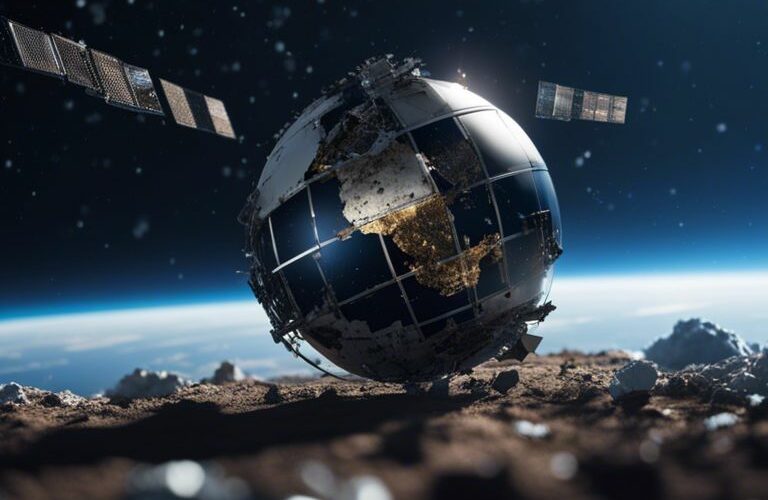Danger lurks in the vast expanse of space, not from unknown alien creatures, but from something much closer to home – space trash. The debris left behind from previous space missions, satellites, and rocket launches poses a significant threat to the safety of future space missions. As the amount of space junk continues to increase, the risk of collisions with operational spacecraft also rises. This not only endangers astronauts but could also disrupt vital communication satellites and other crucial space infrastructure. Understanding the hidden dangers of space trash is essential for ensuring the success and safety of our future endeavors in space.
Table of Contents
Understanding Space Trash
For centuries, humans have been exploring space and sending various objects into orbit around Earth. However, this exciting venture has led to a significant issue known as space debris or space trash. This debris poses a threat to future space missions and could have severe implications for both astronauts and spacecraft.
Types of Space Debris
Space debris comes in various forms, including derelict spacecraft, fragmentation debris from spacecraft breakups, old rocket bodies, and even smaller fragmentsThere are currently over 128 million such objects larger than 1mm in size, posing a significant risk to operational missions in space. The high speeds of these debris mean even small pieces can cause substantial damage to spacecraft.
Perceiving the types of space debris is crucial in developing strategies to mitigate their impact on future space missions. Understanding their origins and behaviors can help in creating effective solutions to manage and reduce the growing issue of space trash.
| Derelict Spacecraft | Spacecraft Breakups |
| Old Rocket Bodies | Fragmentation Debris |
| Small Fragments | Over 128 million objects larger than 1mm |
Origins of Space Trash
With the continued advancement of space exploration, the buildup of space debris has become a pressing concern. Space debris originates from a variety of sources, including defunct satellites, spent rocket stages, and even flecks of paint that have chipped off from spacecraft. These objects remain in orbit around Earth, posing a risk to operational missions and the International Space Station.
Debris in space can also result from intentional acts, such as anti-satellite missile tests, which create thousands of new pieces of debris in orbit. Understanding the origins of space trash is essential in developing measures to prevent further accumulation and minimize the risks associated with existing debris fields.
Risks to Space Missions
Collision Threats to Satellites and Spacecraft
Any satellite or spacecraft operating in low Earth orbit faces the constant risk of colliding with the massive amount of space debris littering this region. Even small pieces of debris traveling at high speeds can cause significant damage to operational satellites and spacecraft. The risk of collision increases exponentially as the amount of space debris continues to grow, posing a serious threat to current and future space missions.
Furthermore, the impact of a collision with space debris can create even more debris, setting off a chain reaction known as the Kessler Syndrome. This scenario could potentially render certain orbits unusable due to the high density of debris, further complicating future space activities. Mitigation efforts are crucial to minimizing the risk of collisions and ensuring the sustainability of space operations.
Implications for Future Space Exploration
With the increasing amount of space debris in Earth’s orbit, future space exploration missions face heightened risks as they navigate through this hazardous environment. The presence of debris raises concerns about the safety of spacecraft and astronauts, potentially jeopardizing the success of missions beyond Earth’s orbit. As we plan for ambitious missions to the moon, Mars, and beyond, addressing the threat of space debris becomes even more critical.
Missions to explore distant planets or establish bases on celestial bodies will require careful planning and innovative solutions to mitigate the risks posed by space debris. The development of advanced debris tracking systems and technologies to remove debris from orbit will be essential to safeguarding the future of space exploration. Collaboration among space agencies and industry partners will be key to ensuring the sustainability of space activities for generations to come.
Mitigating the Dangers
Current Strategies and Technologies
Your journey into space is at risk from the hidden danger of space trash, but there are strategies and technologies in place to mitigate these risks. Space agencies and organizations are constantly monitoring objects in orbit using radar systems and telescopes to track their movements and predict potential collisions. Additionally, spacecraft are equipped with propulsion systems that can be used to maneuver away from debris if necessary.
Dangers posed by space debris are also being addressed through active debris removal initiatives. Some experimental missions have been conducted to test technologies for capturing and removing defunct satellites or fragments of debris from orbit. These efforts aim to reduce the amount of space junk and minimize the risk of collisions with operational spacecraft.
The Role of International Cooperation
The collaboration between different countries and space agencies plays a crucial role in addressing the challenges posed by space debris. Organizations such as NASA, ESA, and other international partners work together to share data, coordinate tracking efforts, and develop common guidelines for debris mitigation. By working together, the global community can better protect space assets and ensure the sustainability of space activities for future generations.
Plus, international cooperation enables the pooling of resources and expertise to tackle the problem of space debris more effectively. By sharing knowledge and technologies, countries can work towards a safer and more sustainable environment in space, paving the way for continued exploration and innovation beyond Earth’s atmosphere.
Adopting Sustainable Space Practices
Keep our skies clear and our future missions safe by adopting sustainable space practices. As the amount of space debris continues to increase, it is crucial for space-faring nations and organizations to take proactive measures to mitigate this growing threat.
Long-term Solutions for Debris Removal
One of the key strategies for tackling space trash is implementing long-term solutions for debris removal. This involves developing technologies and methods to actively remove defunct satellites, spent rocket stages, and other debris from orbit. Concepts such as debris removal spacecraft equipped with nets or robotic arms are being explored to capture and safely de-orbit space junk.
Another approach is designing spacecraft and satellites with end-of-life disposal in mind, ensuring that they either burn up upon re-entry into the Earth’s atmosphere or are propelled into a higher “graveyard” orbit where they pose minimal risk to operational spacecraft.
Developing Space Trash Regulations and Guidelines
Regulations play a crucial role in shaping the behavior of spacefaring entities and promoting responsible space practices. By developing space trash regulations and guidelines, authorities can establish standards for debris mitigation, disposal, and collision avoidance. This can help prevent the creation of new space debris and ensure that existing objects are managed in a sustainable manner.
Debris monitoring and reporting requirements can also be included in these regulations to enhance transparency and accountability in space activities. By fostering international cooperation and compliance with agreed-upon guidelines, we can work towards a cleaner and safer space environment for future generations.
Summing up
From above, it is clear that space trash poses a significant threat to future space missions. The accumulation of debris in Earth’s orbit increases the risk of collisions, which can damage or destroy satellites and spacecraft, endangering human lives and hindering our ability to explore and utilize space. It is crucial for countries and space agencies to take proactive measures to mitigate this hidden danger by implementing better debris removal strategies, improving international collaboration, and designing spacecraft with end-of-life disposal in mind. Only through coordinated efforts can we ensure the sustainability and safety of our activities in space.
FAQ
Q: What is space trash?
A: Space trash, also known as space debris or space junk, refers to defunct human-made objects in space, including nonfunctional spacecraft, abandoned launch vehicle stages, and fragments from disintegration, erosion, and collisions.
Q: How does space trash impact future space missions?
A: Space trash poses a significant threat to future space missions by increasing the risk of collisions with operational spacecraft, which can result in damage, destruction, or even mission failure.
Q: Why is space trash a hidden danger?
A: Space trash is a hidden danger because most of it is too small to be tracked continuously, making it difficult for operators to predict and avoid potential collisions with active spacecraft.
Q: What are the potential consequences of space trash collisions?
A: Potential consequences of space trash collisions include generating more debris, which can further exacerbate the problem, as well as jeopardizing the safety of astronauts, damaging satellites, and disrupting crucial services such as communication and navigation.
Q: What measures are being taken to mitigate the impact of space trash on future space missions?
A: To mitigate the impact of space trash, measures such as implementing debris mitigation guidelines, developing active debris removal technologies, and improving tracking and monitoring capabilities are being pursued to ensure the sustainability of space activities and the safety of space assets.

Our contributing author is a passionate advocate for eco-friendly living and sustainability. With a background in eco-life, they are dedicated to inspiring and empowering individuals to adopt environmentally conscious lifestyles. Through insightful articles, they share practical tips, innovative solutions, and thought-provoking perspectives to promote a greener, more sustainable world. Join them on the journey towards eco-smart living and discover how small choices can make a big impact. 🌱









